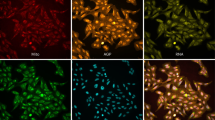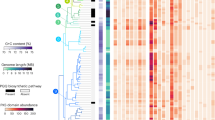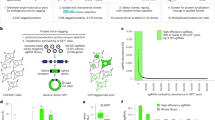Abstract
Aneuploidy, referring here to genome contents characterized by abnormal numbers of chromosomes, has been associated with developmental defects, cancer and adaptive evolution in experimental organisms1,2,3,4,5,6,7,8,9. However, it remains unresolved how aneuploidy impacts gene expression and whether aneuploidy could directly bring about phenotypic variation and improved fitness over that of euploid counterparts. Here we show, using quantitative mass spectrometry-based proteomics and phenotypic profiling, that levels of protein expression in aneuploid yeast strains largely scale with chromosome copy numbers, following the same trend as that observed for the transcriptome, and that aneuploidy confers diverse phenotypes. We designed a novel scheme to generate, through random meiotic segregation, 38 stable and fully isogenic aneuploid yeast strains with distinct karyotypes and genome contents between 1N and 3N without involving any genetic selection. Through quantitative growth assays under various conditions or in the presence of a panel of chemotherapeutic or antifungal drugs, we found that some aneuploid strains grew significantly better than euploid control strains under conditions suboptimal for the latter. These results provide strong evidence that aneuploidy directly affects gene expression at both the transcriptome and proteome levels and can generate significant phenotypic variation that could bring about fitness gains under diverse conditions. Our findings suggest that the fitness ranking between euploid and aneuploid cells is dependent on context and karyotype, providing the basis for the notion that aneuploidy can directly underlie phenotypic evolution and cellular adaptation.
This is a preview of subscription content, access via your institution
Access options
Subscribe to this journal
Receive 51 print issues and online access
$199.00 per year
only $3.90 per issue
Buy this article
- Purchase on Springer Link
- Instant access to full article PDF
Prices may be subject to local taxes which are calculated during checkout



Similar content being viewed by others
Accession codes
Data deposits
Microarray data are deposited in ArrayExpress under accession numbers E-MTAB-318 and E-MTAB-325. Sequencing data are deposited in the NCBI SRA database under accession number SRP003582.
References
Torres, E. M., Williams, B. R. & Amon, A. Aneuploidy: cells losing their balance. Genetics 179, 737–746 (2008)
Weaver, B. A. & Cleveland, D. W. Does aneuploidy cause cancer? Curr. Opin. Cell Biol. 18, 658–667 (2006)
Selmecki, A., Forche, A. & Berman, J. Aneuploidy and isochromosome formation in drug-resistant Candida albicans . Science 313, 367–370 (2006)
Polakova, S. et al. Formation of new chromosomes as a virulence mechanism in yeast Candida glabrata . Proc. Natl Acad. Sci. USA 106, 2688–2693 (2009)
Dunham, M. J. et al. Characteristic genome rearrangements in experimental evolution of Saccharomyces cerevisiae . Proc. Natl Acad. Sci. USA 99, 16144–16149 (2002)
Gresham, D. et al. The repertoire and dynamics of evolutionary adaptations to controlled nutrient-limited environments in yeast. PLoS Genet. 4, e1000303 (2008)
Rancati, G. et al. Aneuploidy underlies rapid adaptive evolution of yeast cells deprived of a conserved cytokinesis motor. Cell 135, 879–893 (2008)
Selmecki, A., Gerami-Nejad, M., Paulson, C., Forche, A. & Berman, J. An isochromosome confers drug resistance in vivo by amplification of two genes, ERG11 and TAC1 . Mol. Microbiol. 68, 624–641 (2008)
Selmecki, A. M., Dulmage, K., Cowen, L. E., Anderson, J. B. & Berman, J. Acquisition of aneuploidy provides increased fitness during the evolution of antifungal drug resistance. PLoS Genet. 5, e1000705 (2009)
Hughes, T. R. et al. Widespread aneuploidy revealed by DNA microarray expression profiling. Nature Genet. 25, 333–337 (2000)
Torres, E. M. et al. Effects of aneuploidy on cellular physiology and cell division in haploid yeast. Science 317, 916–924 (2007)
Williams, B. R. et al. Aneuploidy affects proliferation and spontaneous immortalization in mammalian cells. Science 322, 703–709 (2008)
Pavelka, N., Rancati, G. & Li, R. Dr Jekyll and Mr Hyde: role of aneuploidy in cellular adaptation and cancer. Curr. Opin. Cell Biol. advance online publication 10.1016/j.ceb.2010.06.003 (23 July 2010)
Parry, E. M. & Cox, B. S. The tolerance of aneuploidy in yeast. Genet. Res. 16, 333–340 (1970)
St Charles, J., Hamilton, M. L. & Petes, T. D. Meiotic chromosome segregation in triploid strains of Saccharomyces cerevisiae . Genetics 10.1534/genetics.110.121533 (10 August 2010)
Mack, M. et al. Genetic characterization of hyperresistance to formaldehyde and 4-nitroquinoline-N-oxide in the yeast Saccharomyces cerevisiae . Mol. Gen. Genet. 211, 260–265 (1988)
Washburn, M. P., Wolters, D. & Yates, J. R., III Large-scale analysis of the yeast proteome by multidimensional protein identification technology. Nature Biotechnol. 19, 242–247 (2001)
Gavin, A. C. et al. Proteome survey reveals modularity of the yeast cell machinery. Nature 440, 631–636 (2006)
de Godoy, L. M. et al. Comprehensive mass-spectrometry-based proteome quantification of haploid versus diploid yeast. Nature 455, 1251–1254 (2008)
Gasch, A. P. et al. Genomic expression programs in the response of yeast cells to environmental changes. Mol. Biol. Cell 11, 4241–4257 (2000)
Springer, M., Weissman, J. S. & Kirschner, M. W. A general lack of compensation for gene dosage in yeast. Mol. Syst. Biol. 6, 368 (2010)
Florens, L. & Washburn, M. P. Proteomic analysis by multidimensional protein identification technology. Methods Mol. Biol. 328, 159–175 (2006)
Eng, J. K., McCormack, A. L. & Yates, J. R. An approach to correlate tandem mass spectral data of peptides with amino acid sequences in a protein database. J. Am. Soc. Mass Spectrom. 5, 976–989 (1994)
Zhang, Y., Wen, Z., Washburn, M. P. & Florens, L. Refinements to label free proteome quantitation: how to deal with peptides shared by multiple proteins. Anal. Chem. 82, 2272–2281 (2010)
Ihaka, R. & Gentleman, R. R. A language for data analysis and graphics. J. Comput. Graph. Statist. 5, 299–314 (1996)
Acknowledgements
We thank C. W. Seidel for assistance with microarray data analysis, B. Fleharty and A. Peak for technical assistance with microarray hybridization, A. Perera and K. Walton for assistance in genome resequencing, W. McDowell for technical assistance with qPCR, J. Haug for technical support with flow cytometry experiments, G. Chen for technical suggestions, and A. Paulson for assistance with the submission of microarray and sequencing data to public repositories. This work was performed to fulfil, in part, requirements for J. Zhu’s PhD thesis research as a student registered with the Open University. This work was supported by NIH grant RO1GM059964 to R.L.
Author information
Authors and Affiliations
Contributions
N.P., G.R. and R.L. designed the study. N.P., G.R. and J.Z. performed all experiments. N.P. developed all custom R scripts. N.P., G.R., J.Z., W.D.B. and B.W.S. set up the high-throughput qPCR method. W.D.B. performed all qPCR karyotyping assays. A.S. and L.F. performed mass spectrometry experiments. N.P., G.R., A.S. and L.F. analysed proteomics data. N.P., G.R. and G.L.H. analysed sequencing data. R.L. coordinated and supervised the project. N.P., G.R. and R.L. prepared figures and wrote the manuscript. All authors read and agreed the paper content.
Corresponding author
Ethics declarations
Competing interests
The authors declare no competing financial interests.
Supplementary information
Supplementary Information
This file contains Supplementary Figures 1-12 with legends, Supplementary Methods, Supplementary Tables 1-5 and additional references. (PDF 1093 kb)
Supplementary Data 1
This file contains detailed peptide and spectral counts for proteins detected by MudPIT analysis of whole-cell lysates from Saccharomyces cerevisiae strains with different chromosome copy numbers. (XLS 7911 kb)
Rights and permissions
About this article
Cite this article
Pavelka, N., Rancati, G., Zhu, J. et al. Aneuploidy confers quantitative proteome changes and phenotypic variation in budding yeast. Nature 468, 321–325 (2010). https://doi.org/10.1038/nature09529
Received:
Accepted:
Published:
Issue Date:
DOI: https://doi.org/10.1038/nature09529
This article is cited by
-
The reckoning of chromosomal instability: past, present, future
Chromosome Research (2024)
-
Cancer genomes tolerate deleterious coding mutations through somatic copy number amplifications of wild-type regions
Nature Communications (2023)
-
Modeling specific aneuploidies: from karyotype manipulations to biological insights
Chromosome Research (2023)
-
Consequences of gaining an extra chromosome
Chromosome Research (2023)
-
Effects of aneuploidy on cell behaviour and function
Nature Reviews Molecular Cell Biology (2022)
Comments
By submitting a comment you agree to abide by our Terms and Community Guidelines. If you find something abusive or that does not comply with our terms or guidelines please flag it as inappropriate.



